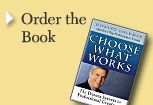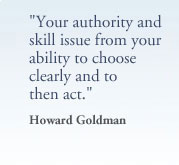
|
|||||||

| Excerpts |
||
| From the Introduction | ||
|
This book is conceived as a vehicle to support your achievements. I have created an effective toolkit for you to use in your work and in other areas of your life where you seek greater accomplishment. Most people apply the coaching to work, so most of the examples and exercises are directed at this arena. However, you will find that the personal aspects of communication and relationship usually come into play as they underpin your primary professional ambitions. The foundation of this work is a set of compelling ideas and questions. These concepts are designed to guide you to view your work, your life, and your current practices in an alternative light. You will then be free to make choices that are consistent with your freely chosen intentions rather than shaped by your history. |
||
From Chapter 1 Our human "operating system" is composed of thoughts, emotions, and reactions. These thoughts, emotions, and reactions are a form of communication that is sent and received in a silent "conversation" we conduct in our head. This internal conversation is mostly unobserved moment by moment. As with the computer, the human operating system can be understood as the main control program, or platform, that is always present. This unexamined operating layer drives (or conversely limits) our performance, our achievement, our ability to connect to others, and our sense of ourselves. |
||
From Chapter 2 We live in a world of perception and interpretation that seems normal to us. We know how things "are." As a result, we have a sense of what is real and what is not. People, situations, and objects in our world have qualities that are "given." These qualities are generally accepted and rarely questioned. We also regard ourselves in ways that we seldom question beyond the obvious. Within our self-referential framework, we think we know who we are, how we feel, and what we want. Our normal world is structured and solidified through our words, understanding, and beliefs. The resulting worldview is "known" and held in place by unconscious agreement within our own rationale and with others. As we come to understand this worldview, we will see it as a product of our unexamined operating system, and its concealed logic. |
||
From Chapter 3 Sure, in most cases, you can be responsible for what you say. This level of responsibility qualifies you as an adult. Far more elusive is observing how we listen to the world. By listening, I don't mean the mechanics of using the little bones in your middle ear to hear. Rather, I am talking about how you pay attention to the world, how you analyze and assess, and observe. This interior practice involves how you interpret what's happening and the range of responses you have to that input. |
||
From Chapter 10 However, another prototype of coaching is a great deal more effective. In this case, the coaching is based on a strong relationship, one that is dedicated to improving and sustaining performance. All world-class performers — athletes, opera singers, and politicians — enjoy coaching relationships. These relationships are not basically designed to fix something that's broken. Instead, the coaching is offered and accepted from the notion that you are already whole. Rather than being need based, this level of coaching is founded in possibility. The relationship is formulated and tuned to the achievement high performance. |
||
From Chapter 11 I have the highest respect for the theory and practice of selling. Selling takes place in virtually every interaction. It can occur with the very human qualities of connectedness, interest, honesty, liveliness, and self-expression. In every conversation, we either buy what they offer, or we sell "I'm not interested" to them. We sell the waitress on providing prompt service at lunch (and she buys it, or she doesn't), or she sells us on the proposition that she's too busy to be especially attentive (and we buy it, or we don't). Someone's sellin'; someone's buyin'. You and I have alternatives to the gravitational pull of controlling, forceful selling. These options are crafted from the values of the High-Performance Operating System: inclusion, clarity, communication, relationship, inspiration, and choice. I call these options mobilization. |
||
From Chapter 12 Closure is a method of communicating that brings order and meaning to a process, cycle of activity, or relationship. It is a way for you to recognize and express where you are, so you can then move your commitments forward. An essential routine, closure corrects situations where we start boldly, wander though the convolutions of circumstance, and then allow matters to trail off into uncharted oblivion. Closure is required where things change, and those changes are not acknowledged or discussed. It is not necessarily a destination, or the final point, as commonly characterized. Rather, reaching closure is an entry point to a new cycle.
|
 |
|
|
